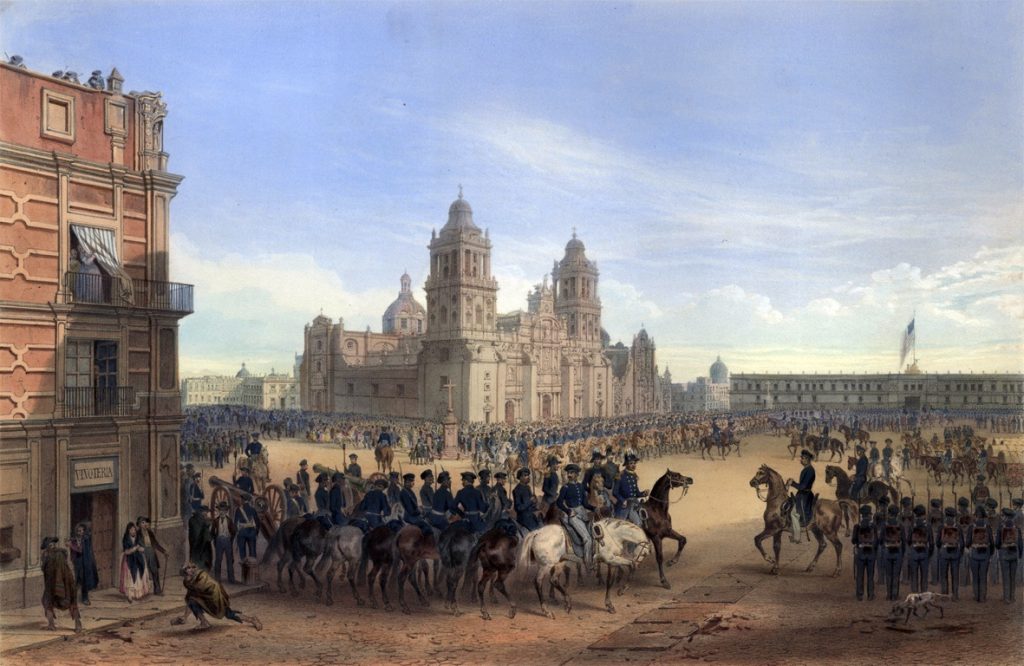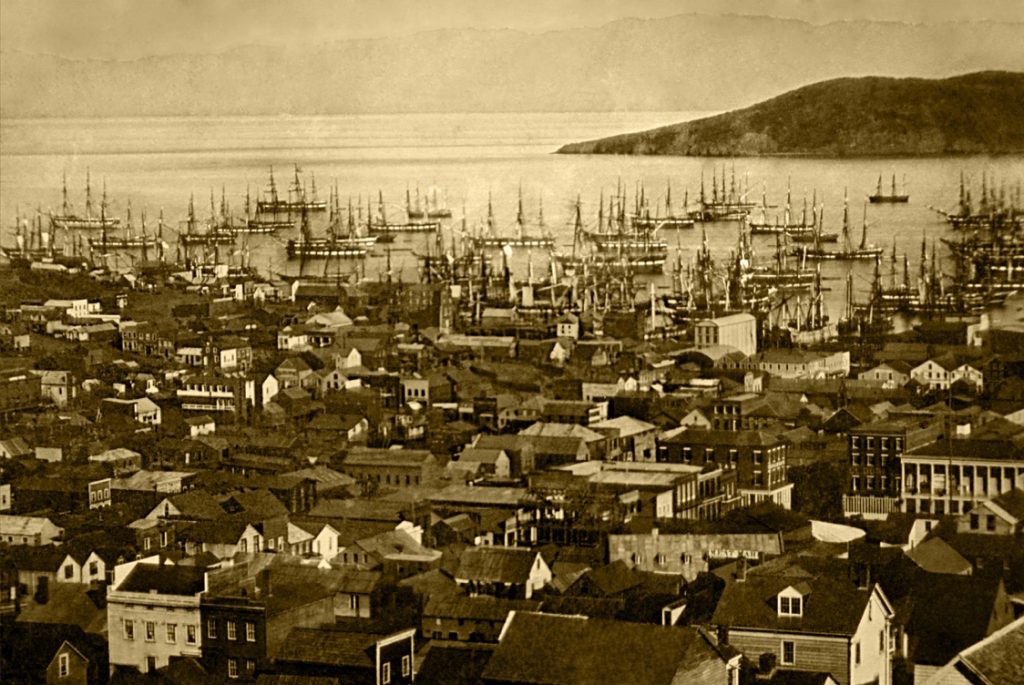Territorial expansion into the southwest and towards the Pacific Ocean was one of the defining features of mid-19th century American history. For many Americans in the 19th century, this territory represented a land of opportunity where a self-made man or woman could secure the American dream. However, America’s territorial expansion did not come peacefully or occur without debate, and by the middle of the 19th century, it had played a central role in the Mexican-American War. And, for the majority of American migrants to California and the new American southwest in the middle of the 19th century, the reality of daily life would prove far different than the visions of abundant land and wealth they had imagined back east.
Conquering the West
After gaining its independence from Spain in 1821, Mexico hoped to attract new settlers to its northern areas to create a buffer between it and the powerful Comanche. New immigrants, mostly from the southern United States, poured into Mexican Texas. Over the next twenty-five years, concerns over growing Anglo influence and possible American designs on the area produced great friction between Mexicans and the former Americans in the area. In 1829, Mexico, hoping to quell both anger and immigration, outlawed slavery and required all new immigrants to convert to Catholicism. American immigrants, eager to expand their agricultural fortunes, largely ignored these requirements. In response, Mexican authorities closed their territory to any new immigration in 1830 – a prohibition ignored by Americans who often squatted on public lands.
In 1834, an internal conflict between federalists and centralists in the Mexican government led to the political ascendency of General Antonio Lopez de Santa Anna. Santa Anna, governing as a dictator, pursued a policy of authoritarian central control, and crushed several revolts throughout Mexico. Anglo settlers in Mexican Texas, or Texians as they called themselves, opposed Santa Anna’s centralizing policies and met in November. They issued a statement of purpose that emphasized their commitment to the Constitution of 1824 and declared Texas to be a separate state within Mexico. After the Mexican government angrily rejected the offer, Texian leaders soon abandoned their fight for the Constitution of 1824 and declared independence on March 2, 1836. The Texas Revolution of 1835-1836 was a successful secessionist movement in the northern district of the Mexican state of Coahuila y Tejas that resulted in an independent Republic of Texas.
At the Alamo and Goliad, Santa Anna crushed smaller rebel forces and massacred hundreds of Texian prisoners. The Mexican army pursued the retreating Texian army deep into East Texas, spurring a mass panic and evacuation by American civilians known as the “Runaway Scrape.” The confident Santa Anna consistently failed to make adequate defensive preparations; an oversight that eventually led to a surprise attack from the outnumbered Texian army led by Sam Houston on April 21, 1836. The battle of San Jacinto lasted only eighteen minutes and resulted in a decisive victory for the Texians, who retaliated for previous Mexican atrocities by killing fleeing and surrendering Mexican soldiers for hours after the initial assault. Santa Anna was captured in the aftermath and compelled to sign the Treaty of Velasco on May 14, 1836, by which he agreed to withdraw his army from Texas and acknowledged Texas independence. Although a new Mexican government never recognized the Republic of Texas, the United States and several other nations gave the new country diplomatic recognition.
Texas annexation had remained a political landmine since the Republic declared independence from Mexico in 1836. American politicians feared that adding Texas to the Union would provoke a war with Mexico and re-ignite sectional tensions by throwing off the balance between free and slave states. However, after his expulsion from the Whig party, President John Tyler saw Texas statehood as the key to saving his political career. In 1842, he began work on opening annexation to national debate. Harnessing public outcry over the issue, Democrat James K. Polk rose from virtual obscurity to win the presidential election of 1844. Polk and his party campaigned on promises of westward expansion, with eyes toward Texas, Oregon, and California. In the final days of his presidency, Tyler at last extended an official offer to Texas on March 3, 1845. The republic accepted on July 4, becoming the twenty-eighth state. Mexico denounced annexation as “an act of aggression, the most unjust which can be found recorded in the annals of modern history.” Beyond the anger produced by annexation, the two nations both laid claim over a narrow strip of land between two rivers. Mexico drew the southwestern border of Texas at the Nueces River, but Texans claimed that the border lay roughly 150 miles further west at the Rio Grande. Neither claim was realistic since the sparsely populated area, known as the Nueces strip, was in fact controlled by Native Americans.
In November of 1845, President Polk secretly dispatched John Slidell to Mexico City to purchase the Nueces strip along with large sections of New Mexico and California. The mission was an empty gesture, designed largely to pacify those in Washington who insisted on diplomacy before war. Predictably, officials in Mexico City refused to receive Slidell. In preparation for the assumed failure of the negotiations, Polk preemptively sent a 4,000 man army under General Zachary Taylor to Corpus Christi, Texas, just northeast of the Nueces River. Upon word of Slidell’s rebuff in January 1846, Polk ordered Taylor to cross into the disputed territory. The President hoped that this show of force would push the lands of California onto the bargaining table as well. Unfortunately, he badly misread the situation. After losing Texas, the Mexican public strongly opposed surrendering any more ground to the United States. Popular opinion left the shaky government in Mexico City without room to negotiate. On April 24, Mexican cavalrymen attacked a detachment of Taylor’s troops in the disputed territory just north of the Rio Grande, killing eleven U.S. soldiers. It took two weeks for the news to reach Washington.
Congress passed a declaration of war on May 13. Upon declaring war in 1846, Congress issued a call for 50,000 volunteer soldiers. Spurred by promises of adventure and conquest abroad, thousands of eager men flocked to assembly points across the country. In the early fall of 1846, the U.S. Army invaded Mexico on multiple fronts and within a year’s time General Winfield Scott’s men took control of Mexico City. However, the city’s fall did not bring an end to the war. Scott’s men occupied Mexico’s capital for over four months while the two countries negotiated. In the United States, the war had been controversial from the beginning. Embedded journalists sent back detailed reports from the front lines, and a divided press viciously debated the news. Volunteers found that war was not as they expected. Disease killed seven times as many American soldiers as combat. Harsh discipline, conflict within the ranks, and violent clashes with civilians led soldiers to desert in huge numbers. Peace finally came on February 2, 1848 with the signing of the Treaty of Guadalupe Hidalgo.

The new American Southwest attracted a diverse group of entrepreneurs and settlers to the commercial towns of New Mexico, the fertile lands of eastern Texas, and the famed gold deposits of California, and the Rocky Mountains. This postwar migration built earlier paths dating back to the 1820s, when the lucrative Santa Fe trade enticed merchants to New Mexico and generous land grants brought numerous settlers to Texas. The Gadsden Purchase of 1854 further added to American gains north of Mexico.
California, belonging to Mexico prior to the war, was at least three arduous months travel from the nearest American settlements. There was some sparse settlement in the Sacramento valley and missionaries made the trip occasionally. The fertile farmland of Oregon, like the black dirt lands of the Mississippi valley, attracted more settlers than California. Dramatized stories of Indian attacks filled migrants with a sense of foreboding, although the majority of settlers encountered no violence and often no Indians at all. The slow progress, disease, human and oxen starvation, poor trails, terrible geographic preparations, lack of guidebooks, threatening wildlife, vagaries of weather, and general confusion were all more formidable and frequent than Indian attacks. Despite the harshness of the journey, by 1848 there were approximated 20,000 Americans living west of the Rockies, with about three-fourths of that number in Oregon.
Many who moved nurtured a romantic vision of life, attracting more Americans who sought more than agricultural life and familial responsibilities. The rugged individualism and military prowess of the West, encapsulated for some by service in the Mexican war, drew a growing new breed west of the Sierra Nevada to meet with the Californians already there; a breed of migrants different from the modest agricultural communities of the near-west. If the great draw of the West served as manifest destiny’s kindling, then the discovery of gold in California was the spark that set the fire ablaze. The vast majority of western settlers sought land ownership, but the lure of getting rich quick drew younger single men (with some women) to gold towns throughout the West. These adventurers and fortune-seekers then served as magnets for the arrival of others providing services associated with the gold rush. Towns and cities grew rapidly throughout the West, notably San Francisco whose population grew from about 500 in 1848 to almost 50,000 by 1853. Lawlessness, predictable failure of most fortune seekers, racial conflicts, and the slavery question all threatened manifest destiny’s promises.

On January 24, 1848 James W. Marshall, a contractor hired by John Sutter, discovered gold on Sutter’s sawmill land in the Sacramento valley area of the California Territory. Throughout the 1850s, Californians beseeched Congress for a transcontinental railroad to provide service for both passengers and goods from the Midwest and the East Coast. The potential economic benefits for communities along proposed railroads made the debate over the route rancorous. The great influx of diverse people clashed in a combative and aggrandizing atmosphere of individualistic pursuit of fortune. Linguistic, cultural, economic, and racial conflict roiled both urban and rural areas. By the end of the 1850s, Chinese and Mexican immigrants made up 1/5th of the mining population in California. The ethnic patchwork of these frontier towns belied a clearly defined socio-economic arrangement that saw whites on top as landowners and managers with poor whites and ethnic minorities working the mines and assorted jobs. The competition for land, resources, and riches furthered individual and collective abuses particularly against Indians and older Mexican communities. California’s towns, as well as those dotting the landscape throughout the West, such as Coeur D’Alene in Idaho and Tombstone in Arizona, struggled to balance security with economic development and the protection of civil rights and liberties.
Source: Joshua Beatty et al., “Manifest Destiny,” Joshua Beatty and Gregg Lightfoot, eds., in The American Yawp, Joseph Locke and Ben Wright, eds., last modified August 1, 2017, http://www.AmericanYawp.com.
Conquering the West – Video
Conquering the West
Crash Course US History. 2013, June 6. War and Expansion. Retrieved from https://www.youtube.com/watch?v=tkdF8pOFUfI
Summary
The Mexican-American War had an enormous impact on both the United States and Mexico. The American victory helped set the United States on the path to becoming a world power. It elevated Zachary Taylor to the presidency and served as a training ground for many of the Civil War’s future commanders. Most significantly, however, Mexico lost roughly half of its territory. For the United States, the conflict over whether or not to extend slavery into the newly won territory pushed the nation ever closer to disunion and civil war, helped create the boundaries of modern America, and would ultimately pave the way for American settlement into the southwest and California.
Source: Joshua Beatty et al., “Manifest Destiny,” Joshua Beatty and Gregg Lightfoot, eds., in The American Yawp, Joseph Locke and Ben Wright, eds., last modified August 1, 2017, http://www.AmericanYawp.com.
